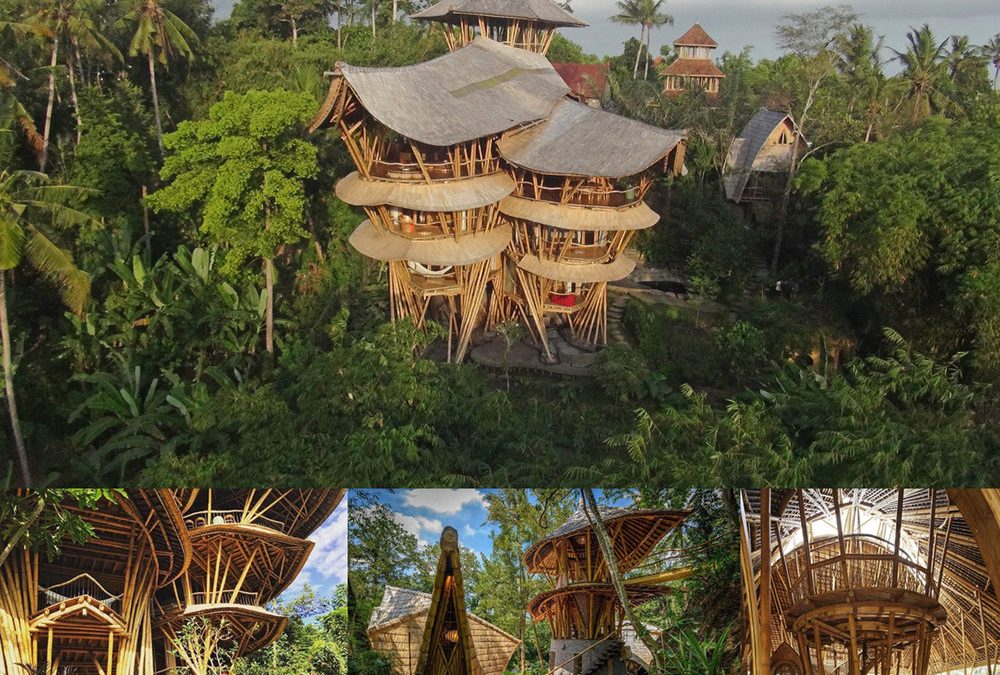Bamboo is a mystical plant: a symbol of strength, flexibility, tenacity, and endurance. Throughout Asia, for centuries bamboo has been integral to religious ceremonies, art, music, and daily life. It can be found in paper, the brush, and the inspiration for poems and paintings. It is a material that had interested me for a long time and I yearned to know more about it.
In early 2017 I undertook an immersive course just outside Ubud in Bali, Indonesia called ‘Bamboo University’ run in collaboration with Ibuku. Ibuku is a team of young designers, architects and engineers exploring ground-breaking ways of using bamboo to build homes, hotels, schools, and event spaces in Bali, Indonesia. As part of the course we visited a number of buildings completed by Ibuku which crush the misconceptions about the applicability or limitations of bamboo in contemporary architecture.
A selection of works by Ibuku built almost entirely from bamboo
Ibuku is spearheaded by Elora Hardy, the daughter of John Hardy, well known for his conception of The Green School in Bali which is an inspirational project bringing sustainable education to the youth that attend the school.
Bamboo is a highly efficient building material. The key advantages of bamboo are:
- Bamboo does not need to be sawn into a profile, instead it can be used in the round. This significantly reduces the processing required.
- Bamboo has a hollow core, giving it a structurally efficient cross section.
- Bamboo has a strength close to concrete, and its strength-to-weight ratio is similar to steel.
- Bamboo grows in 3 to 5 years compared to 30 to 50 years for most softwoods and hardwoods.
- The use of bamboo has historically been limited due to decay and fire risk. However, treatments have been developed to eliminate these risks.
- More than 1500 species thrive in diverse terrain on every continent but the poles. It also grows the fastest: Some species grow one and a half meters a day!
Model making of a theoretical bamboo structure
The course was an idea originally conceived to help teach professionals about the potential of bamboo as a green building material. In its current form it is a design and bamboo building workshop. We spent time visiting Ibuku creations, model making and constructing 1:1 structures from bamboo.
Learning joinery techniques from Iocal builders
The latter portion of the course was dedicated to constructing an open form structure built entirely from bamboo save for a few bolts and a metal roof. I learnt that building with bamboo requires an entire shift in perspective as few of the techniques used in conventional timber frame construction are applicable.
Whilst bamboo as a material has advantages such as its lightness, strength and flexibility it does have limitations that need to be addressed in order to achieve a prolonged lifespan. Bamboo has a low natural resistance (1 to 3 years) against attacks by fungi and insects. It is difficult to treat with normal preservative methods since its outer membrane is impermeable to liquids. At Ibuku, they treat bamboo with a natural Boron salt solution, which protects it from insect attack for a life-long period.
Bamboo is also sensitive to direct UV exposure. The surface of bamboo becomes rough under UV exposure, and the strength of exposed bamboo can reduce significantly. High energy UV radiation leads to evaporation of water under the surface, and cracks will enable water to escape from the bamboo. The UV exposure also breaches the chemical bond at the surface of bamboo.
The application of bamboo in the Australian construction market (beyond decorative applications) is fraught with obstacles at present: there is limited documentation on the structural behaviour of the material and the skills and knowledge required both for construction and certification limits opportunities. However, there are architects pioneering its use such as Cave Urban whose research and work includes bamboo structures at the annual Bondi exhibition, Sculpture by the Sea.
Sculpture by the Sea exhibit by Cave Urban
In our world of depleting resources bamboo is a sustainable, fast growing, strong alternative to timber. With a tensile strength superior to mild steel and a weight-to-strength ratio surpassing that of graphite, bamboo is the strongest growing woody plant on earth with one of the widest ranging habitats. With time, the applicability and use of bamboo will be adopted by the industry realising its true potential… and when it does there will be an irreversible shift in the construction industry.


Recent Comments